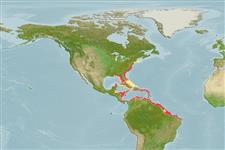>
Beloniformes (Needle fishes) >
Belonidae (Needlefishes)
Etymology: Strongylura: Greek, strongylos = round + Greek, oura = tail (Ref. 45335).
More on author: Walbaum.
Environment: milieu / climate zone / depth range / distribution range
Ökologie
seewasser; süßwasser; brackwasser riff-verbunden; tiefenbereich 0 - ? m. Subtropical; 45°N - 9°S, 88°W - 34°W
Western Atlantic: Maine, USA and northern Gulf of Mexico to Brazil. Absent from the Bahamas and Antilles (Ref. 3129).
Size / Gewicht / Alter
Maturity: Lm ? range ? - ? cm
Max length : 111 cm TL Männchen/unbestimmt; (Ref. 40637); common length : 60.0 cm TL Männchen/unbestimmt; (Ref. 5217); max. veröff. Gewicht: 2.3 kg (Ref. 40637)
Rückenflossenweichstrahlen (insgesamt): 14-17; Afterflossenweichstrahlen: 16 - 20. Black pigment behind eye, not extending below level of middle of eye (Ref. 26938).
Inhabits coastal areas and mangrove-lined lagoons. Enters freshwater. Feeds mainly on small fishes. Oviparous (Ref. 205). Eggs may be found attached to objects in the water by tendrils on the egg's surface (Ref. 205). Only the right gonad is developed (Ref. 26938). Marketed fresh.
Life cycle and mating behavior
Geschlechtsreife | Fortpflanzung | Ablaichen | Eier | Fecundity | Larven
Robins, C.R. and G.C. Ray, 1986. A field guide to Atlantic coast fishes of North America. Houghton Mifflin Company, Boston, U.S.A. 354 p. (Ref. 7251)
IUCN Rote Liste Status (Ref. 130435)
Bedrohung für Menschen
Harmless
Nutzung durch Menschen
Fischereien: weniger kommerziell; Sportfisch: ja
Mehr Information
ReferenzenAquakulturAquakultur ProfilZuchtlinienGenetikElectrophoresesVererbbarkeitKrankheitenVerarbeitungNutrientsMass conversion
PartnerBilderStamps, Coins Misc.LauteCiguateraGeschwindigkeitSchwimmstilKiemenoberflächeOtolithsGehirngrößeSehfähigkeit
Tools
Zusatzinformationen
Download XML
Internet Quellen
Estimates based on models
Preferred temperature (Ref.
123201): 13.3 - 28, mean 26.1 °C (based on 304 cells).
Phylogenetic diversity index (Ref.
82804): PD
50 = 0.5001 [Uniqueness, from 0.5 = low to 2.0 = high].
Bayesian length-weight: a=0.00129 (0.00079 - 0.00211), b=3.05 (2.92 - 3.18), in cm total length, based on LWR estimates for this species & Genus-body shape (Ref.
93245).
Trophic level (Ref.
69278): 3.0 ±0.0 se; based on diet studies.
Widerstandsfähigkeit (Ref.
120179): mittel, Verdopplung der Population dauert 1,4 - 4,4 Jahre. (Preliminary K or Fecundity.).
Fishing Vulnerability (Ref.
59153): High to very high vulnerability (67 of 100).
Nutrients (Ref.
124155): Calcium = 32.1 [9.6, 151.2] mg/100g; Iron = 0.502 [0.206, 1.149] mg/100g; Protein = 17.7 [15.6, 19.7] %; Omega3 = 0.165 [0.065, 0.473] g/100g; Selenium = 18.3 [7.7, 45.7] μg/100g; VitaminA = 51.5 [13.5, 245.1] μg/100g; Zinc = 0.78 [0.47, 1.31] mg/100g (wet weight);
